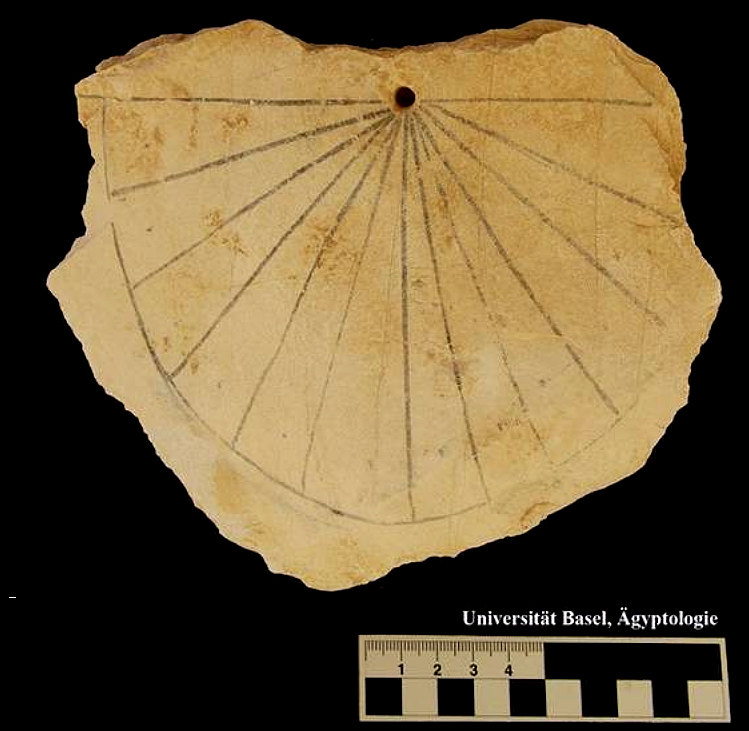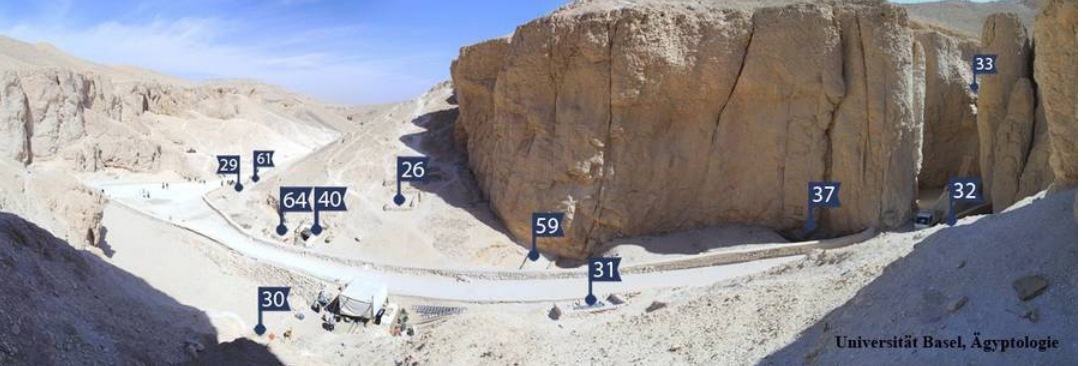
[photo Courtesy University of Basel]
|
Professor Dr. Susanne Bickel and her archeological team from the University of Basel found one of the oldest sundials in the world during this year’s excavation in the Valley of the Kings. A limestone sundial was found near tomb KV61 during a survey of the surface rubble. The location of the dial corresponds to an area where there are remains of workmen’s huts dating to the Ramesside Period of the 13th century BCE.
The dial was most likely a vertical, south facing sundial. The horizon line of the dial is about 16 cm across with a hole at the mid point to hold a simple horizontal metal rod or wood stick gnomon, indicating that the gnomon displayed shadows of temporal (seasonally uneven) hours. The limestone dial has a black painted semicircle. On each side of the vertical noon line are 6 segments of about 15 degrees each, representing morning and afternoon temporal (seasonally uneven) hours. Small dots in the middle of each hourly segment serve for even finer timing. Nevertheless, the hour lines are not drawn with precision.
The archeologists speculate that since the subdivision of the solar cycle in hours was a key aspect of depictions on the walls of the royal tombs where illustrated texts describe the nightly journey of the sun god through the underworld, the sundial could have supported the observations and visualization of this journey. Or the sundial could have been used as a simple clock by the workmen that toiled away digging and decorating the Ramesside tombs.
Read more at: University of Basel News Release 14 March, 2013

[photo courtesy of the University of Basel]
|
The details of the 2013 season excavation and survey for the University of Basel archeologists are found in their in Preliminary Report on the Work Carried Out During the Season 2013: Univ. Basel - Valley of the Kings Preliminary Report 2013
About 30m from KV64, a tomb of the 18th Dynasty, is KV 61 a single-room tomb that probably was never used. Near the site the limestone shard sundial was discovered. Here are extracts from the Preliminary Report:
“In preparation for the reopening and investigation of KV 61, part of the area above this tomb and in between KV 61 and KV 29 was cleared. On the east side of KV 61 the slope of the hill consists of a high heap of limestone debris, probably coming from the excavations of H. Carter and Th. Davis. This area must have been originally occupied by workmen’s huts in the Ramesside Period [so-called after the eleven kings who took the name Ramesses (1292-1069 BC)]. The back wall of a hut, which was partly discovered already in 2012, was found in this season. On the hill slope behind the hut were a few remains of wooden fragments with hieroglyphic inscriptions mentioning the name of king Amenhotep III."
“Some pottery originating from the huts as well as shards belonging to some funerary equipment were found in the area East of the hut and to the North of KV 29. Several limestone fragments of ostraca were found under a clean layer of sand and limestone chips inside the hut but also behind its wall in the East. A particularly interesting piece is an ancient sundial, which appears to be one of the oldest of its kind.”
"The remains of the huts will be included to the topographical map in the coming season. Further huts have probably been removed during the discovery of KV 61 in 1910 by E. H. Jones, who was working for Th. Davis. Today some big stones, similar to the discovered walls, are visible in the modern debris above KV 61. Our clearing of the area between KV 29 and KV 61 is done in order to secure the tombs and to prepare the entrance of KV 61 for an iron door in the coming season."
"We would like to express our sincere thanks to the Minister of State for Antiquities Dr. Mohamed Ibrahim and the Secretary General Adel Abd el-Satar, to the Director of Foreign Missions Dr. Mohamed Ismail Khaled, to the General Director of the Antiquities of Egypt Dr. Mohamed el-Bialy, to the Director of Luxor Mr. Mansour Boreik and to the Inspectorate of Western Thebes and its General Director Dr. Mohamed Abd El-Aziz, to the Director of the Westbank Mr. Nour Abd El-Ghaffar, to the Director of the Valley of the Kings Mr. Aiman Mohamed Ibrahim and Inspector Mr. Mahmud Hosni, to the Director of the Carter museum magazine Yahya Abdel Aal and Inspector Said Mamduh for their helpful cooperation, assistance and advice during our working season."
For even more about the tombs in the Valley of the Kings, see American Univ in Cairo - Theban Mapping Project
